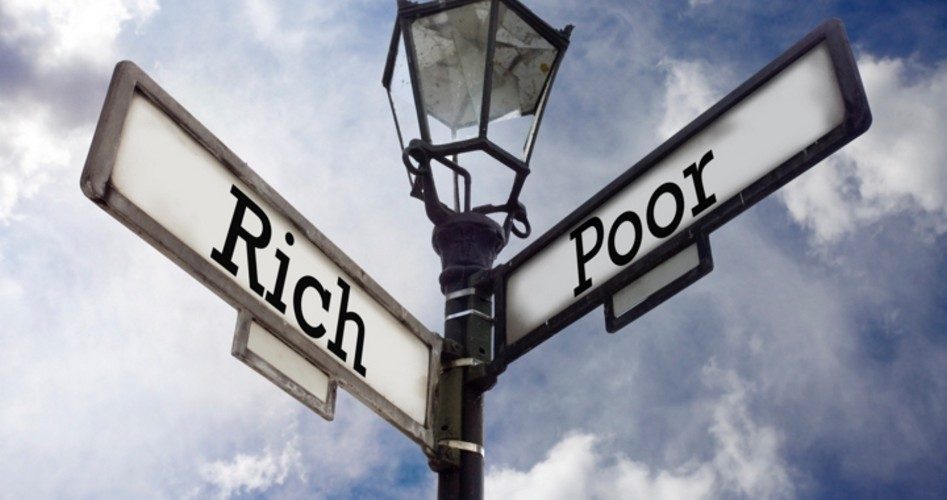
In his zeal to prove the specter of “income inequality” that has been talked about by every Democrat running for the presidency, New York Times writer David Leonhardt turned out a 1,400-word book report. The book in question, The Triumph of Injustice, written by a couple of left-wing professors at the University of California, Berkeley, claims that, thanks to Trump’s tax policies, the rich pay a lower tax rate on their income than do the rest of us. Wrote Leonhardt,
The overall tax rate on the richest 400 households last year was only 23 percent, meaning that their combined tax payments equaled less than one quarter of their total income….
President Trump’s 2017 tax cut helped push the tax rate on the 400 wealthiest households below the rates for almost everyone else.
This is proof positive of the present inequity of the system since the “overall rate was 70 percent in 1950 and 47 percent in 1980.” In other words, in the upside-down world of liberal economic thinking, higher taxes on the wealthy is a good thing, while allowing them to keep more of their wealth for themselves is a bad thing.
Leonhardt added that it’s a class struggle between the “haves” and the “have-nots” of classical Marxist theory: “[The UCB professors] portray the history of American taxes as a struggle between people who want to tax the rich and those who want to protect the fortunes of the rich.”
This is the first of many distortions in the book. At the Republic’s founding, the authors of the Constitution weren’t interested in doing anything more than binding the central or national government down from mischief by delineating and limiting its powers. Readers of the Federalist Papers will be hard-pressed to find any discussion about protecting the wealth of the rich.
Adam Michel, a policy analyst at the Heritage Foundation, found many other errors in the study touted by Leonhardt. He discovered that, in order to claim that the tax rate on the highest-income Americans was 23 percent in 2017, the professors “had to cook the books, systematically inflating the income of the richest Americans … and leaving out important transfer programs for poor Americans.”
Michel concluded,
Looking at all federal taxes, the Congressional Budget Office shows that the top 1% pays an average federal tax rate of 33.3%. The data shows tax rates decline with income, and the poorest 20% of the population pays an average tax rate of just 1.7%….
Democrats can still argue for higher taxes on the wealthy, but we need to acknowledge that according to the best estimates, the highest-income Americans already send about half of their earnings to the government.
Michel’s conclusions were backed up by an analysis from the Tax Policy Center, a nonpartisan research group: “For 2018, households in the top 20% will have income of about $150,000 or more (and 52% of total income), about the same as in 2017. But they will pay about 87% of income taxes, up from about 84% last year.”
For the UCB professors even that isn’t good enough. From the book’s flyleaf one learns that the professors “propose a visionary, democratic, and practical reinvention of taxes, outlining reforms that can allow tax justice to triumph in today’s globalized world and democracy to prevail over concentrated wealth.”
One needs only to remember that the income tax inflicted upon the republic in 1913 was the second plank of the Communist Manifesto: “A heavy progressive or graduated income tax.” As a result, this has systemically, over the past hundred years, siphoned hundreds of billions of dollars of private capital out of the economcy and into the government’s coffers. This has starved the economy of needed capital while funding the government’s welfare state programs prohibited by the Constitution.
One needs also to remember that the founding of the Republic was energized by outrage against Britain’s “taxation without representation.” As economic historian Gary North reminded his readers,
The total tax burden imposed by the British Empire on the colonies in 1775, as distinguished from the taxes imposed by colonial legislatures, was approximately 1% of national income in the North, and about 2.5% in the South. The main burden was from customs duties placed on non-British imports into the colonies. These were tariffs, i.e., sales taxes on imports.
Against this “intolerable tax tyranny” of 1%, the colonists were persuaded by political organizers to revolt. They fought and died for seven years. They won in 1783.
The professors and the Times want to extend the present “tax tyranny” under which entrepreneurs now labor even further. The Times used the UCB professors’ flawed and slanted book as its tool. The book review is just another attempt to promote class envy over the alleged “inequality” of the American system that is anathema to every avowed socialist seeking power.
Image: IGphotography via iStock / Getty Images Plus
An Ivy League graduate and former investment advisor, Bob is a regular contributor to The New American, writing primarily on economics and politics. He can be reached at [email protected].

